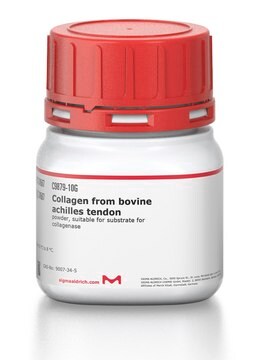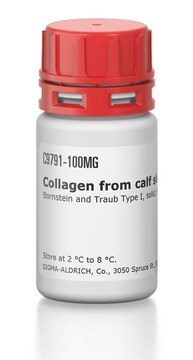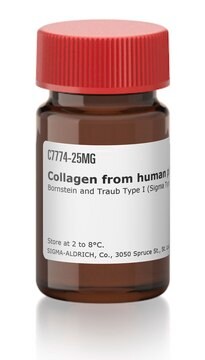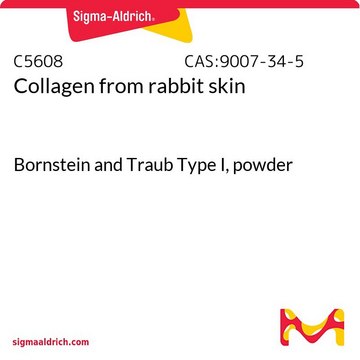推荐产品
生物源
rat tail
品質等級
無菌
sterile
形狀
lyophilized (clear, colorless solution after reconstitution)
包裝
pkg of 30 mg
製造商/商標名
Roche
技術
cell culture | mammalian: suitable
UniProt登錄號
儲存溫度
2-8°C
基因資訊
rat ... Col1a1(29393)
相关类别
一般說明
脊椎动物中胶原蛋白含量丰富。41个特异性基因编码42条多肽链,产生27中胶原蛋白类型。胶原蛋白最主要分布在细胞外基质中。哺乳动物有丰富的胶原蛋白I。胶原蛋白IV是基底膜的重要结构蛋白。它的化学和遗传特性和基质胶原类型I和III以及软骨胶原类型II都不同。
特異性
对大多数哺乳动物细胞有活性。
應用
胶原蛋白备用作培养多种细胞的底物,比如作为培养皿涂层和制备胶原蛋白凝胶。
胶原蛋白用于制备盖玻片涂层溶液和胶原蛋白凝胶收缩分析。
生化/生理作用
胶原蛋白对于多细胞动物来说提供了细胞外支撑。胶原蛋白I提供了机械稳定性,为多种器官,筋,韧带,皮肤,角膜,骨骼和牙本质提供了力量和坚固性。
特點和優勢
内容物
冻干粉,细胞培养级,3瓶10mg
冻干粉,细胞培养级,3瓶10mg
規格
生物活性:测试证明促进HUV-EC细胞粘附。
準備報告
工作浓度:5 μg/cm2
5 μg/cm2用于细胞培养涂层;对于胶原蛋白凝胶制备,终浓度要达到2到3 mg/ml。
5 μg/cm2用于细胞培养涂层;对于胶原蛋白凝胶制备,终浓度要达到2到3 mg/ml。
重構
为了得到最好的结果,在0.2%醋酸(V/V)中溶解冻干粉。
当用于制备胶原蛋白凝胶,瓶子里的药品需要溶解在一个3.3ml无菌0.2%醋酸(V/V)体系中。最终的终浓度为3 mg/ml。
作为培养皿涂层,终浓度应该在1到2mg/ml。
注意:溶解:不要搅动,只需要将醋酸倒在干粉上,让它静置几小时,直到全部溶解。为了完全溶解,可能需要15到25℃培养,最多24小时。
胶原蛋白重构应该在15到25℃之间,更高的温度会破坏纤维,可能阻止后续胶原蛋白凝胶化。
当用于制备胶原蛋白凝胶,瓶子里的药品需要溶解在一个3.3ml无菌0.2%醋酸(V/V)体系中。最终的终浓度为3 mg/ml。
作为培养皿涂层,终浓度应该在1到2mg/ml。
注意:溶解:不要搅动,只需要将醋酸倒在干粉上,让它静置几小时,直到全部溶解。为了完全溶解,可能需要15到25℃培养,最多24小时。
胶原蛋白重构应该在15到25℃之间,更高的温度会破坏纤维,可能阻止后续胶原蛋白凝胶化。
其他說明
仅用于生命科学研究。不可用于诊断。
儲存類別代碼
11 - Combustible Solids
水污染物質分類(WGK)
WGK 1
閃點(°F)
does not flash
閃點(°C)
does not flash
其他客户在看
Myelination of rodent hippocampal neurons in culture.
Gardner A, et al.
Nature Protocols, 7(10), 1774-1774 (2012)
Metastatic potential correlates with enzymatic degradation of basement membrane collagen.
Liotta L A, et al.
Nature, 284(5751), 67-67 (1980)
Collagen: Structure and Mechanics (2008)
Lodish H
Molecular and Cellular Biology (2000)
Amulya K Saxena et al.
Journal of pediatric surgery, 44(5), 896-901 (2009-05-13)
Management of long gap esophageal atresia poses challenges. The surgical techniques for esophageal replacement are associated with complications and high morbidity. The aim of this study was to develop protocols to obtain single layer sheets of esophageal epithelial cells (EECs)
商品
The extracellular matrix (ECM) is secreted by cells and surrounds them in tissues.
The extracellular matrix (ECM) is secreted by cells and surrounds them in tissues.
3D cell culture overview. Learn about 2D vs 3D cell culture, advantages of 3D cell culture, and techniques available to develop 3D cell models
Extracellular matrix proteins such as laminin, collagen, and fibronectin can be used as cell attachment substrates in cell culture.
我们的科学家团队拥有各种研究领域经验,包括生命科学、材料科学、化学合成、色谱、分析及许多其他领域.
联系技术服务部门











